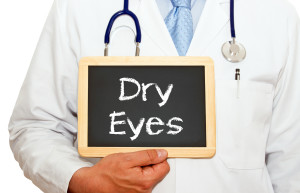Posted by: Metrolina Eye Associates in Dry Eyes

 Dry eye is one of the most common disorders that your eye care provider encounters on a daily basis. Dry eye is not just a disorder; it is a disease that needs chronic treatment, just like blood pressure or cholesterol. According to the National Eye Institute (NEI)/Industry Dry Eye Workshop: “Dry eye is a multifactorial disease of the tears and ocular surface that results in symptoms of discomfort, visual disturbance, and tear film instability with potential to damage the ocular surface. It is accompanied by increased osmolarity of the tear film and inflammation of the ocular surface. “
Dry eye is one of the most common disorders that your eye care provider encounters on a daily basis. Dry eye is not just a disorder; it is a disease that needs chronic treatment, just like blood pressure or cholesterol. According to the National Eye Institute (NEI)/Industry Dry Eye Workshop: “Dry eye is a multifactorial disease of the tears and ocular surface that results in symptoms of discomfort, visual disturbance, and tear film instability with potential to damage the ocular surface. It is accompanied by increased osmolarity of the tear film and inflammation of the ocular surface. “
Typical symptoms that patients present with include stinging, burning, or redness of the eyes often times with foreign body sensation. It is common to have watery eyes with dry eye disease, as this represents the body’s response to the irritation of dry eyes. Due to an uneven tear film, vision can often be blurry and there are usually signs of eye fatigue present.
It used to be thought that all dry eye was a deficiency of tears, so up until recently, most treatments of dry eye focused on tear replacement. Now it is understood, that the majority of dry eye is due not to a lack of tear production, but actually due to evaporation of tears. It turns out that behind the eyelashes, there are oil-producing glands called, meibomian glands. These oil producing glands actually release a small amount of very thin oil that mixes the tears and spreads them out with each blink so the tear film does not evaporate as quickly. These glands in up to 90% of dry eye, do not release enough oil or become plugged up causing dry eye disease to occur. Tear insufficiency dry eye on the other hand can indicate an autoimmune disorder. Other causes include a number of medications and other medical conditions such as an underactive thyroid or diabetes.
For mild cases of dry eye, replacement artificial tears can often times still be helpful. There are numerous OTC eye drops that are preservative-free or can have substances in them mimicking the oil released from the meibomian glands. Restasis is the only prescription-based product for dry eye. It is thought to work by increasing tear production and reducing inflammation on the surface of the eye. Lifitegrast is another medication in clinical testing that may soon become available. It also acts to decrease inflammation on the ocular surface and may become available in late 2016 or early 2017.
For more moderate to severe forms of dry eye, Restasis is often used in coordination with therapies aiming to make the meibomian glands work better. A new eyelid hygiene product, Avenova, has been shown to improve dry eye symptoms by removing the overpopulation of bacteria associated with meibomian gland dysfunction. High-grade, purified Omega-3 products have been beneficial in increasing the oil production from the meibomian glands.
When the meibomian glands become blocked, therapies aimed at unblocking the glands are very helpful. LipiFlow is a treatment that heats the oils and melts them in the meibomian gland, allowing them to be released more effectively. At Metrolina Eye, we offer IPL (intense-pulsed light therapy) for dry eye disease. This therapy is much more effective than LipiFlow and much cheaper for patients. IPL has a direct thermal effect on the meibomian glands just like LipiFlow, but it also works through two other mechanisms of action. IPL can actually change the contour of the gland, allowing it to release oil better. IPL also causes abnormal blood vessels of the eyelid margin to regress away with treatment. These vessels are thought to cause dysfunction of the meibomian gland by delivering inflammatory mediators that clog the glands. IPL is a gentle and safe procedure that allows for long-lasting relief of moderate to severe dry eye symptoms.
To learn more about dry eye disease or see if you can be helped by any of our treatment options, please contact our Metrolina Eye Associates to be seen by one of our skilled eye care professionals!
by:
Ivan Mac, MD/MBA